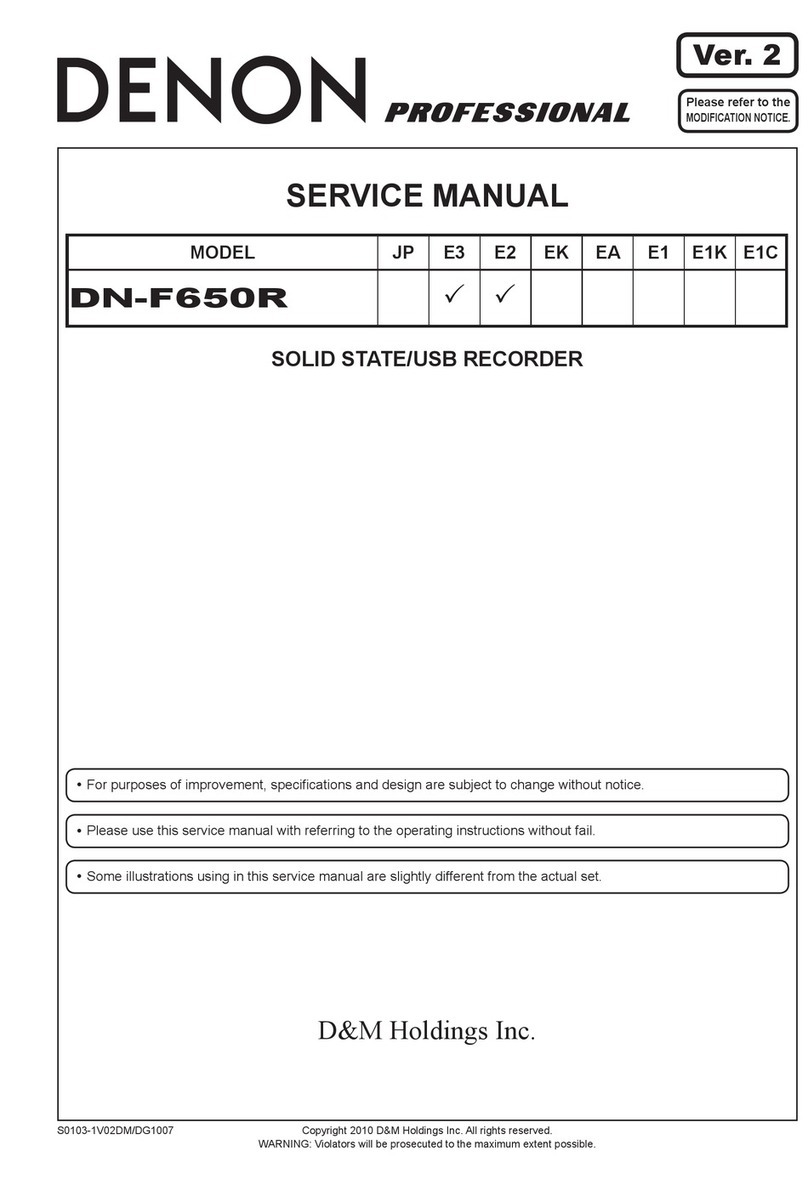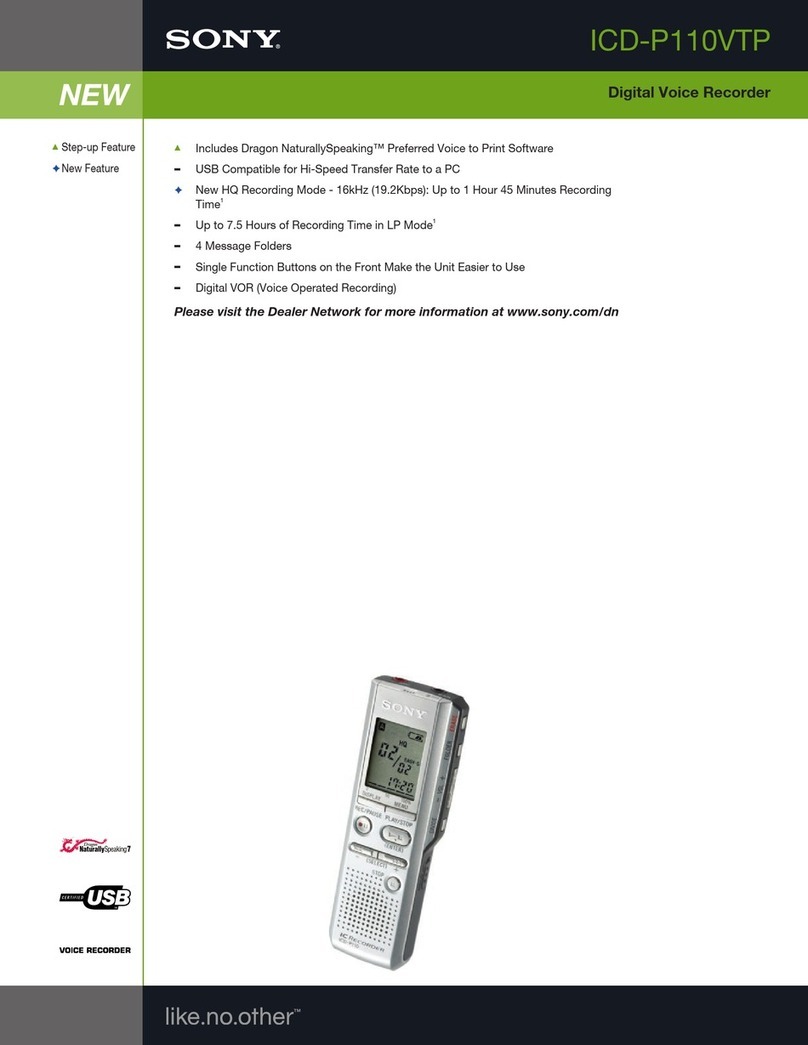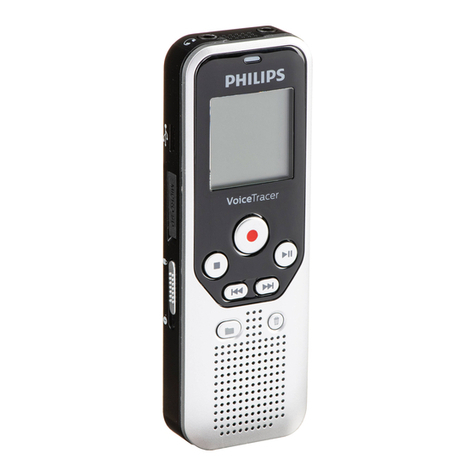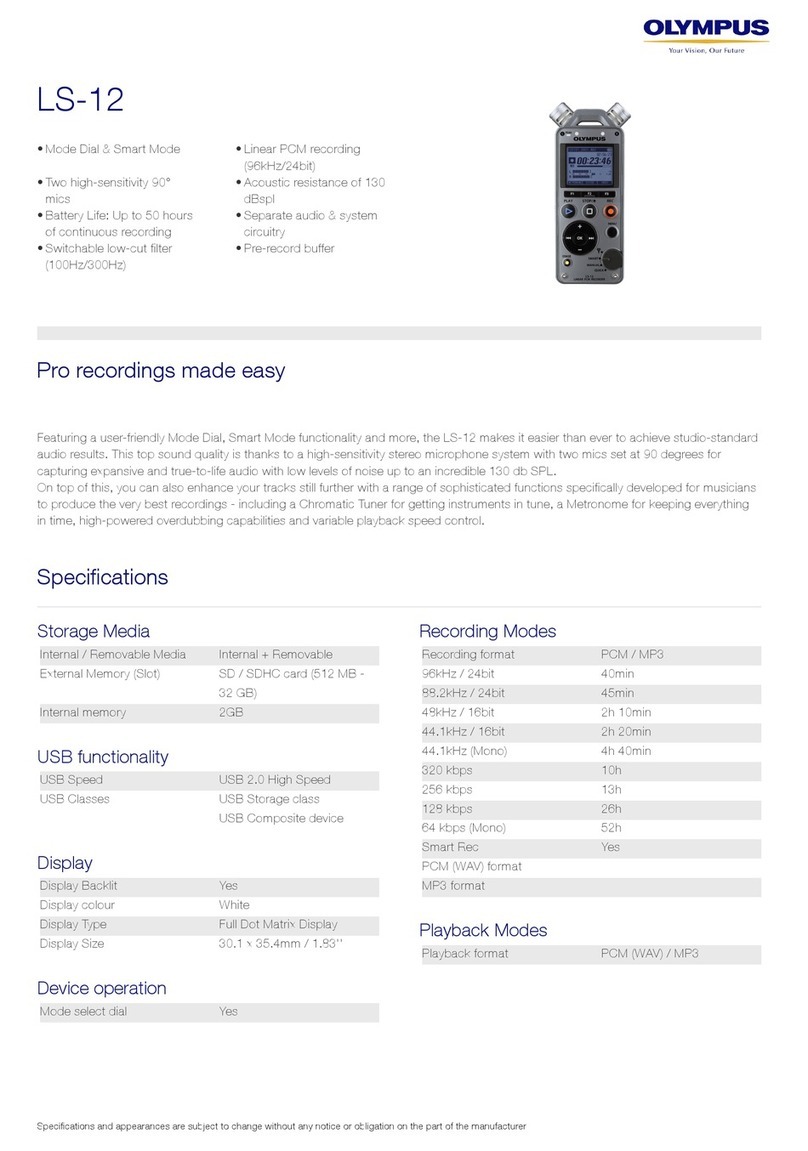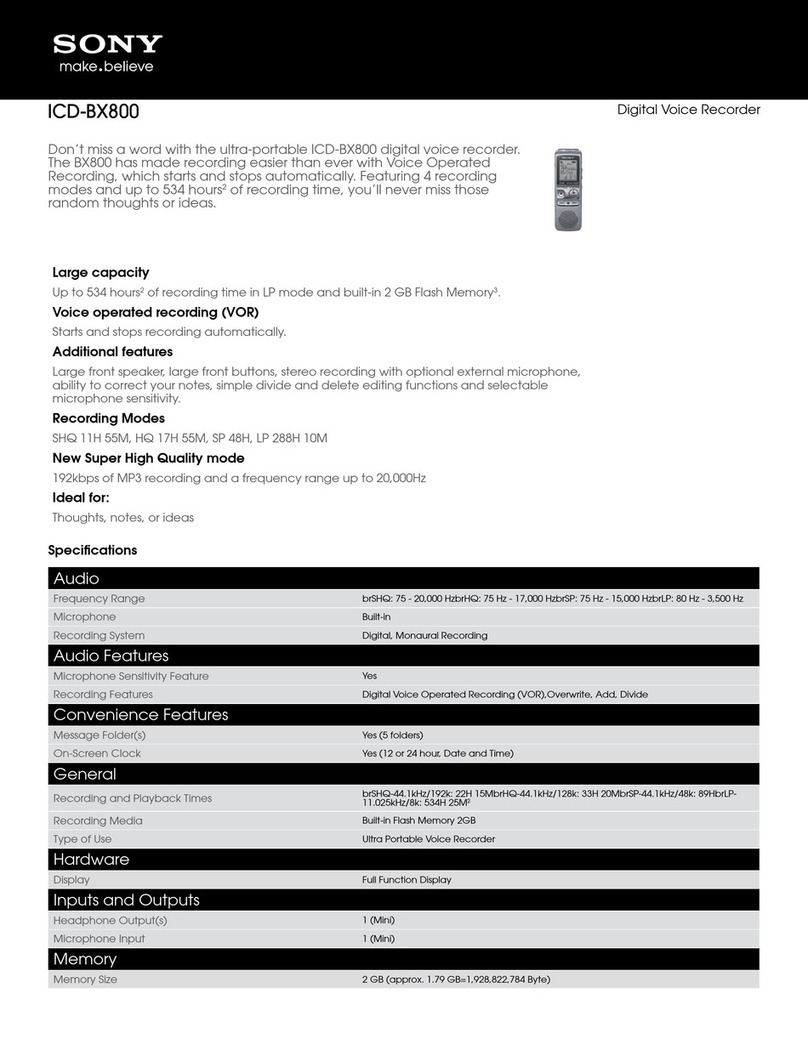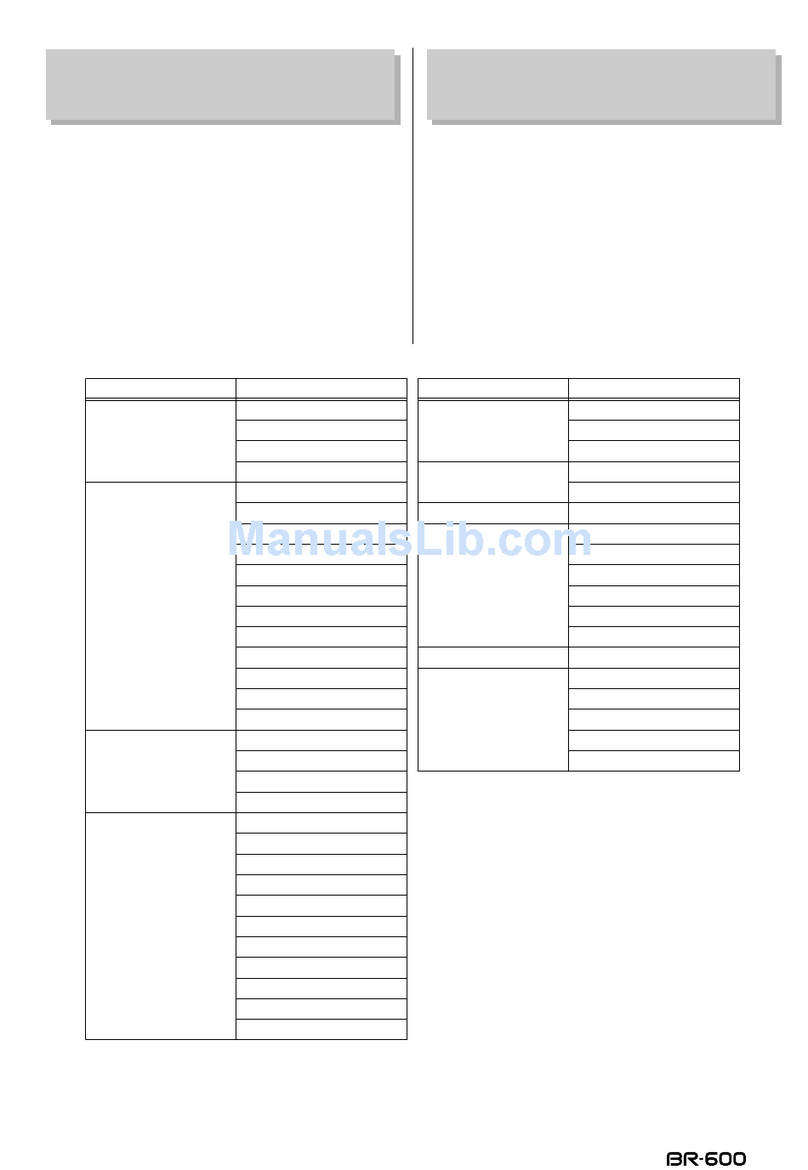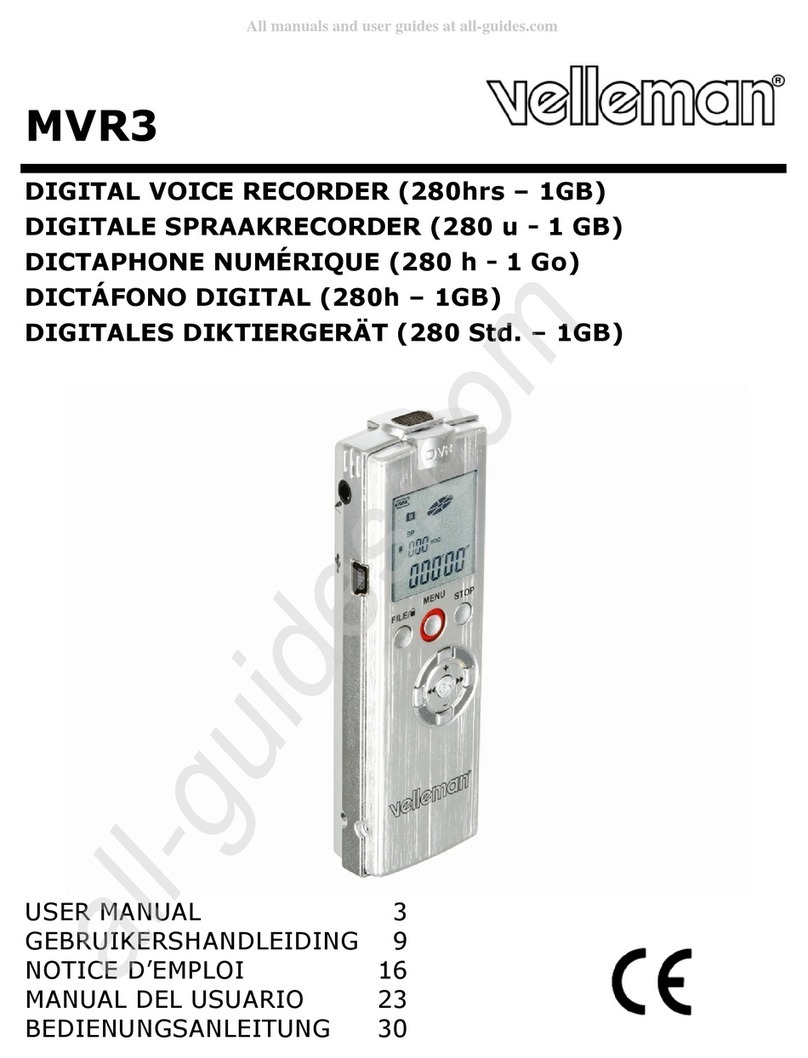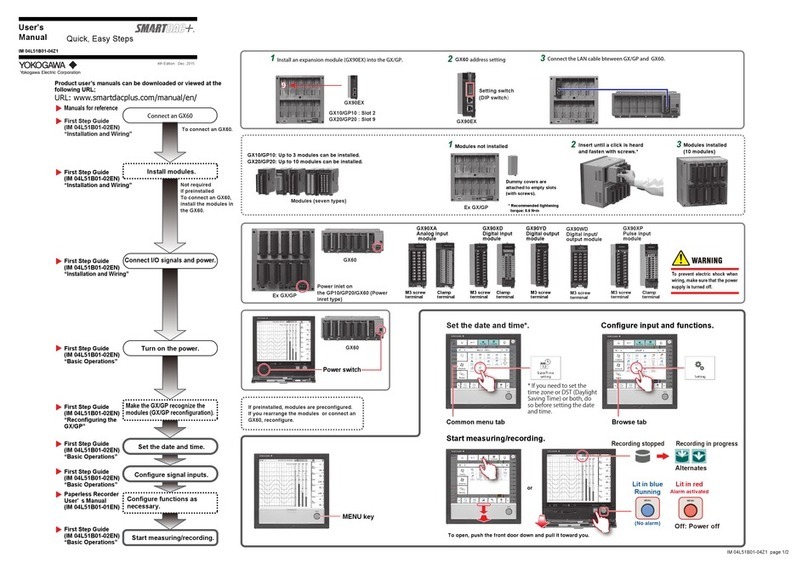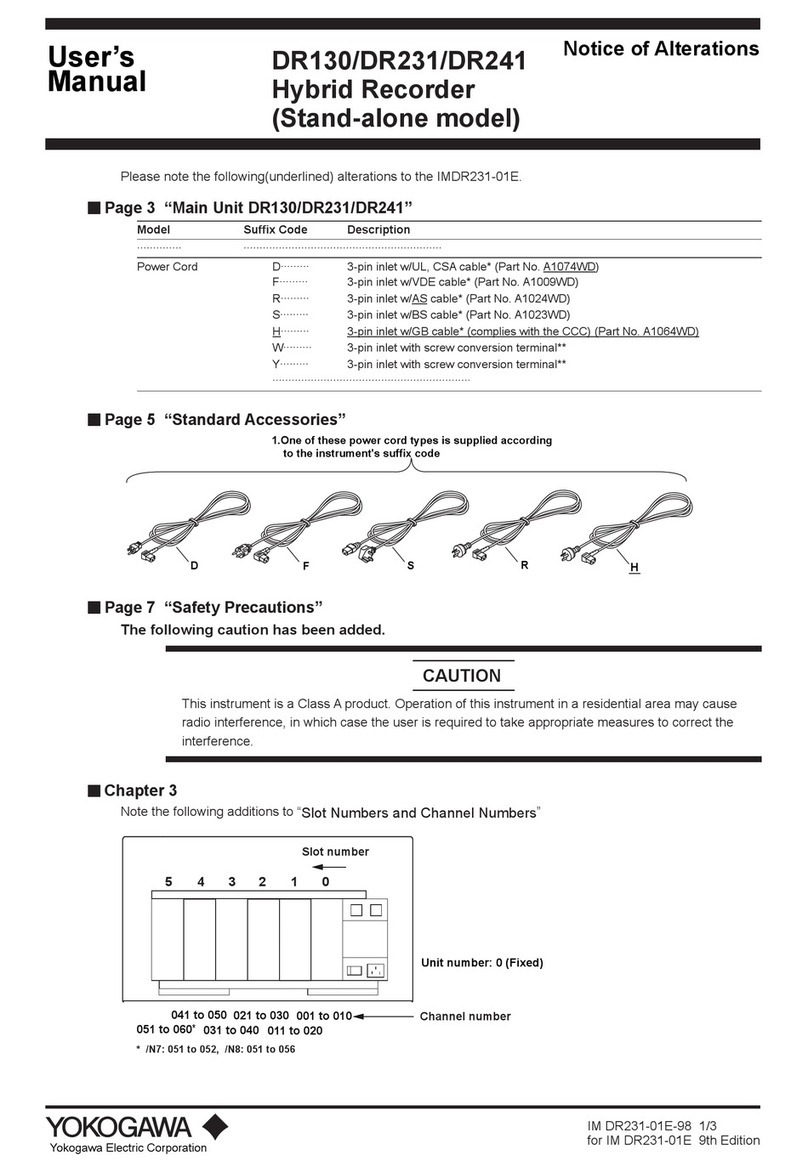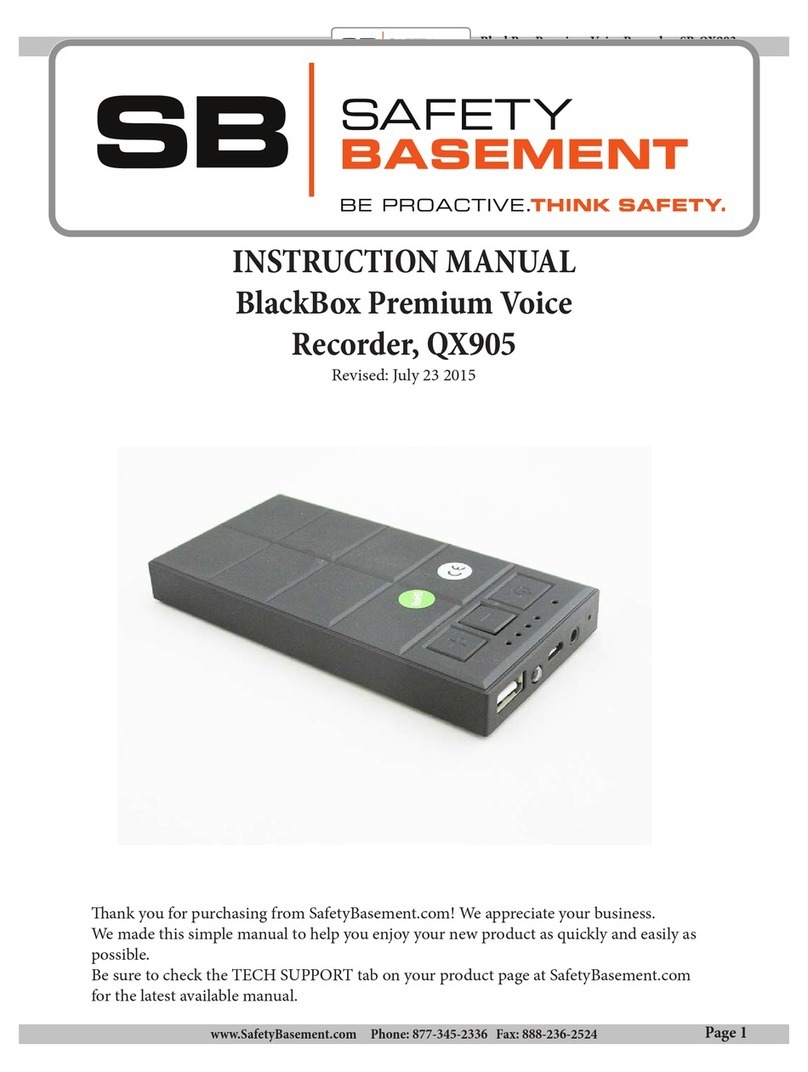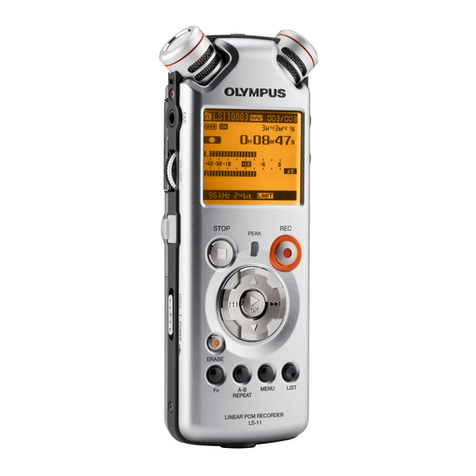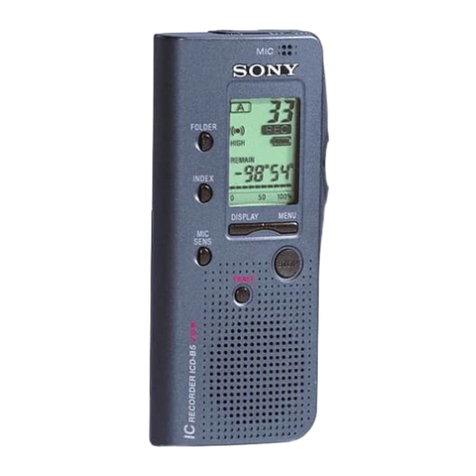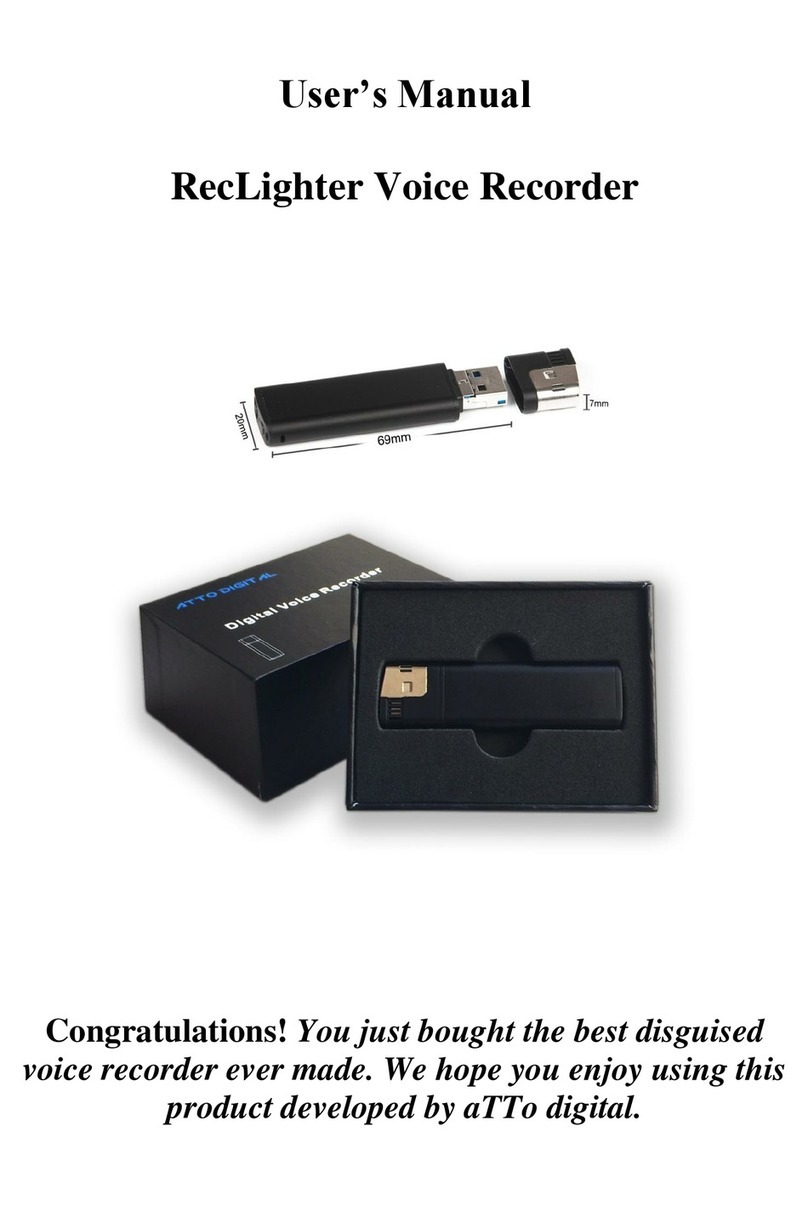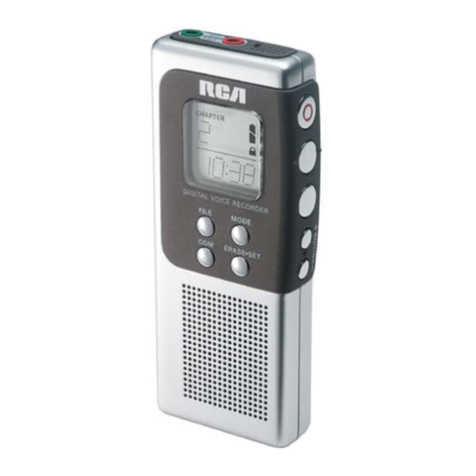Stevens A Series User manual

TYPE A
RECORDER
Model 71, 2004
Publication 93566A
August 2004
DISCONTINUED


Contents
1. Introduction............................................. 1
1.1 General Description................................. 1
1.2 Safety Information.................................. 1
1.3 Basic Instrument Specifications................ 2
2. Installation............................................... 4
2.1 Unpacking............................................. 4
2.2 Equipment & Tools Required.................... 4
2.3 Mounting............................................... 4
2.4 Installing the Chart................................. 5
2.5 Removing the Chart................................ 5
2.6 Positioning the Pen................................. 6
3. Operation................................................ 7
3.1 Quartz Multispeed Timer Drive................. 7
3.2 The Pen................................................ 8
3.3 Gage Scales.......................................... 9
4. Maintenance............................................ 10
4.1 Care of Clocks....................................... 10
4.2 Lubrication............................................ 10
4.3 Spare Parts............................................ 10
6. Technical Notes....................................... 11
6.1 Instrument Accuracy.............................. 11
TABLES
1. Time Scales, QMT.................................... 2
2. Gage Scale, Metric................................... 3
3. Gage Scale, English.................................. 3
4 - 7 Line Shift Error .......................………… 12
8 & 9. Float Lag Error...............…................ 14
Chart Remainder Multipliers....................... 15

Safety and Equipment Protection
WARNINGELECTRICAL POWER CAN RESULT IN
PERSONNEL INJURY/DEATH OR CAN CAUSE
DAMAGE TO EQUIPMENT.
If the instrument is driven by an external power source,
disconnect the instrument from its power source before
attempting any repairs. WARNING BATTERIES ARE
DANGEROUS. IF HANDLED IMPROPERLY, THEY CAN
RESULT IN PERSONNEL INJURY/ DEATH OR CAN
CAUSE DAMAGE TO EQUIPMENT.
Batteries can be hazardous when misused, mishandled,
or disposed of improperly. They may explode or omit
poisonous substances. Batteries contain potential
energy, even when partially discharged,
WARNING
ELECTRICAL SHOCK CAN RESULT IN PERSONNEL
INJURY OR DEATH.
Use extreme caution when handling cables, connectors,
or terminals; they may yield hazardous currents if
inadvertently brought into contact with conductive
materials, including water and the human body.
CAUTION
Be aware of protective measures against environmentally
caused electric-current surges.
In addition to the previous warnings and cautions, the
following safety activities should be carefully observed.
Children- Adolescents
NEVER give batteries to young people who may not be
aware of the hazards associated with batteries and their
improper
Jewelry. Watches, Metal Tags
To avoid severe burns, NEVER wear rings, necklaces,
metal watch bands, bracelets, or metal identification tags
near exposed battery terminals.
Heat, Fire
NEVER dispose of batteries in fire or locate them in
excessively heated spaces. Observe the temperature
limit listed in the Instrument specifications.
Charging
NEVER charge 'dry' cells or lithium batteries that are not
designed to be charged.
NEVER charge rechargeable batteries at currents higher
than recommended ratings.
NEVER recharge a frozen battery. Thaw it completely at
room temperature before connecting charger.
Unvented Container
NEVER store or charge batteries in a gas-tight container.
Doing so may lead to pressure buildup and explosive
concentrations of hydrogen.
Short Circuits
NEVER short circuit batteries. High current flow may
cause internal battery heating and/or explosion.
Damaged Batteries
Personnel injury may result from contact with hazardous
materials from a damaged or open battery. NEVER
attempt to open a battery enclosure. Wear appropriate
protective clothing, and handle damaged batteries
carefully.
Disposal
ALWAYS dispose of batteries in a responsible manner.
Observe all applicable federal, state, and local regulations
for disposal of the specific type of battery involved.
NOTICE
Stevens makes NO claims as to the immunity of its equipment against lightning strikes, either
direct or nearby. The following statement is required by the Federal Communications
Commission.
WARNING - This equipment generates, uses, and can radiate radio frequency energy and, if
not installed in accordance with the instructions manual, may cause interference to radio
communications. It has been tested and found to comply with the limits for a Class A
computing device pursuant to Subpart J of Part 15 of FCC Rules, which are designed to
provide reasonable protection against such interference when operated in a commercial
environment. Operation of this equipment in a residential area is likely to cause interference
in which case the user at his own expense will be required to take whatever measures may
be required to correct the interference.
USER INFORMATION
Stevens makes no warranty as to the information furnished in these instructions and the
reader assumes all risk in the use thereof. No liability is assumed for damages resulting from
the use of these instructions. We reserve the right to make changes to products and/or
publications without prior notice.

1 Introduction
1
1.1 General Description
The Stevens Type A is a float-operated
recorder that provides a permanent,
continuous, long-term graphic record of
water level fluctuations. A precision clock
movement controls the rate at which the
strip chart is advanced. The rise and fall in
of the float moves a marking stylus laterally
across the chart. The stylus or pen will
reverse at each margin so that any range
of water level stage change can be
accommodated.
The water level recording ratio, called
"gage scale", is also selectable. One
traverse across the chart width can
represent anywhere from .25 meters to
12.5 meters of water level change for
Metric models, and 1 foot to 50 feet for
English models (reference Table 5 & 6).
Chart drive is normally accomplished by
use of a battery-operated Quartz
Multispeed Timer unit, using an electronic
control circuit. A wide range of chart
speeds, called "time scales", may be
selected (reference Table 1).
1.2 Safety Information
Before performing any procedure in this
manual, read all applicable warnings and
cautions.

1 Introduction
2
1.3 Basic Instrument
Specifications
Chart Drive (options)
. Quartz Multispeed Timer (QMT)
Time Scale
. Refer to Table 1
Gage Scale
. Refer to Tables 5 and 6
Float Pulley
. 375 mm or 18 in. circumference for
beaded float line or perforated tape
. Optional 750 mm or 36 in.
circumference pulley ring for beaded
float line or perforated float tape
Operating Temperature
. QMT clock drive (alkaline batteries)
0 to +40 degrees Celsius
(+32 to +104 degrees Fahrenheit)
. QMT clock drive (lead-acid battery)
-30 to +50 degrees Celsius
(-22 to +122 degrees Fahrenheit)
Shipping Weight
. 20.5 Kg (45 pounds)
Float Line/Tape
. Stainless steel cable, 125mm or 6 in.
bead spacing
. Stainless steel tape, 125mm or 6 in.
perforation spacing
Recommended Float Size (Diameter)
203 mm (8 in), 254 mm (10 in)
Instrument Size (HxWxD, Cover open)
42 x 64 x 44 cm
(16.5 x 25.1 x 17 in)
Chart
. A-25 (Metric)
. A-10 (English)
Accessories (optional)
. Guide Pulley for float line or tape
Table I
Time Scales, Quartz Multispeed Timer
(switch selectable)
Scale
cm/day
(in/day)
Major
Division
3.0 cm
(1.2 in.)
Minor
Division
.25 cm
(.1 in.)
Chart Life
1.5
(0.6)
48 hrs. 4 hrs. 4 yrs.
3.0
(1.2)
24 hrs. 2 hrs. 2 yrs.
6.1
(2.4)
12 hrs. 1 hr. 1 yr.
12.2
(4.8)
6 hrs. 30 min. 6 mos.
24.4
(9.6)
3 hrs. 15 min. 3 mos.
48.8
(19.2)
1.5 hrs. 7.5
min.
1.5
mos.
97.5
(38.4)
45 min. 3.75
min.
22.5 days

1 Introduction
3
METRIC
GAGE
SCALE
WATER LEVEL
CHANGE, ONE
TRAVERSE OF
CHART
PEN CHG.
PER
METER
OF WATER
VALUE OF
MINOR
DIVISION
FLOAT
PULLEY
SIZE
1:1 .25 m 100 cm .2 cm 375 mm
1:2 .50 m 50 cm .4 cm 750 mm
1:5 1.25 m 20 cm 1.0 cm 375 mm
1:10 2.50 m 10 cm 2.0 cm 750 mm
1:10 2.50 m 10 cm 2.0 cm 375 mm
1:20 5.00 m 5 cm 4.0 cm 750 mm
1:25 6.25 m 4 cm 5.0 cm 375 mm
1:50 12.5 m 2 cm 10.0 cm 750 mm
ENGLISH
GAGE
SCALE
WATER LEVEL
CHANGE, ONE
TRAVERSE OF
CHART
PEN CHG.
PER FOOT
OF WATER
VALUE OF
MINOR
DIVISION
FLOAT
PULLEY
SIZE
10:12 1 ft. 10 in. .01 ft. 18 in.
5:12 2 ft. 5 in. .02 ft. 36 in.
1:6 5 ft. 2 in. .05 ft. 18 in.
1:12 10 ft. 1 in. .1 ft. 36 in.
1:12 10 ft. 1 in. .1 ft. 18 in.
1:24 20 ft. .5 in. .2 ft. 36 in.
1:30 25 ft. .4 in. .25 ft. 18 in.
1:60 50 ft. .2 in. .5 ft. 36 in.
Table II. Gage Scale, Metric
Table III. Gage Scale, English

2 Installation
4
2.1 Unpacking
Remove all shipping tie-downs, packing
pieces, etc. Several parts and accessories
are individually wrapped. Check the Sales
Order to insure that all items are accounted
for before disposing of the packing
materials.
2.2 Equipment and tools required
The following equipment and tools are
usually required for proper installation of
the Type A Recorder:
Float, float pulley, counterweight, float
line or tape, and a set of end hooks.
Guide pulley (if required) and mounting
hardware.
Necessary mounting hardware and tools
(screw drivers, screws, drill, combination
pliers, etc.) as required.
2.3 Mounting
The surface on which the recorder is to be
mounted should be reasonably level. The
recorder's feet are adjustable to
compensate for minor variations. The
recorder can be positioned so that the
input pulley will hang over the edge of the
surface, or holes can be drilled in the
surface to allow for the float line or tape to
pass through. Because the carriage
reverses at each margin, the float pulley
can rotate in either direction for rising water
levels; thus the float can hang off of either
side of the pulley. Position the recorder in
its approximate final position. Final
positioning and securing will be done after
float and counterweight clearance is
checked.
Install the float pulley on the recorder input
shaft. Install the cupped washer with the
recessed side toward the pulley. Thread
the clamping disk onto the pulley shaft.
Thread the hex nut onto the shaft, and
tighten it against the pulley clamp. Loosely
tighten the right- and left-hand screws
down onto the washer, clamping the pulley
in place.
Attach the float line or tape to the two
adjustable end hooks. Adjust the length so
the counterweight does not touch bottom
when the float is at its highest point. Also
verify that the length is great enough so the
counterweight does not run into the
support shelf when the float is at its lowest
position.
A guide pulley can be used to route the
float line or tape for a vertical drop different
than just straight off the float pulley. It is
normally mounted on the underside of the
shelf, and used to shift the counterweight
drop. This is typically done to route the
counterweight out, so it does not hit a large
diameter float, or in closer, for small
diameter stilling wells.
If necessary, extra float line or tape may be
removed. Tape may be broken by sharply
bending it. Beaded float line should be cut
6mm (1/4 in.) beyond a bead to reduce
raveling. Non-beaded cable should be
heated until red hot at the desired point for
annealing, and then cut.
Attach the float and counterweight to
opposite ends of the float line or tape using
the end hooks. Lower the float into the
well. Pass the float line or tape over the
float pulley, engaging the beads or
perforations into their proper position on
the pulley. Lower the counterweight down
the opposite side.

3 Operation
5
Check the final position of the recorder to
be sure the float and counterweight can
move up and down freely, without
interference from the side of the well or any
protuberances. Secure the recorder to the
mounting surface with screws, using the
holes in the recorder feet.
2.4 Installing the Chart
Rotate the pen off the chart. Pull the
friction roller assembly away from the chart
cylinder. Lock it in place by sliding it in the
direction of the "lock" arrow. Remove the
two thumb screw from the sides of the
writing plate and lift the plate out. Remove
the take-up cylinder from the recorder.
Remove the supply cylinder (middle
cylinder) from the recorder, and remove
the large knurled nut from the end.
Observe that the core of the new chart is
flush at one end and protrudes at the other.
Slip the chart onto the supply cylinder,
flush end toward the flange, and tighten the
knurled nut firmly in place. Place the
supply cylinder in its bearings, with the
flange to the left so the chart comes off of
the top of the cylinder. Replace the take-
up cylinder.
Pass the chart behind the drive cylinder
(bottom drum) and out between the
cylinder and the friction rollers. Pull the
chart upward about 1 1/2 inches beyond
the take-up cylinder with the right edge
square to the flange. Reinstall the writing
plate. Pass the chart over the writing plate
and around the front of the take-up
cylinder. Install the half-round paper clamp
from the bottom, pressing downward.
Take the slack out of the chart by winding
the take-up cylinder upward, using the
white knurled flange. Rotate the take-up
cylinder until the chart and pen are
properly positioned for the desired start
point for recording. Unlock the friction
roller assembly and allow it to hold the
paper in place.
2.5 Removing the Chart
Lift the pen from the chart drive cylinder by
simply tilting it back. Pull the friction roller
aware from the chart and slide it in the
direction of the "Lock" arrow. Manually
advance the chart by turning the large,
white knurled disk on the left end of the
take-up cylinder. Do this until the graphic
record is just beyond the edge of the
writing plate. Using the edge of the writing
plate as a guide, cut the chart with a knife.
Lift the take-up cylinder out of the
instrument and slip off the chart. This may
require a firm twisting motion if the chart is
tightly wound. Pull or shake the chart
clamp out of the chart roll. Re-attach the
remaining chart, or install a new chart as
described in section 1.6, above. The A-10
(English) charts have a diagonal blue line
marked at the end of the chart fastened to
the core. When this line appears during
use, the remaining days of supply can be
calculated. On the A-10 chart, count the
number of small divisions (0.1 in) between
the left margin and the blue line. At a chart
speed of 2.4 inches per day, the number of
Take-up Cylinder
Supply Cylinder
Advance Cylinder
Friction
Roller
Chart
Figure 3. Chart Routing

3 Operation
6
days of chart remaining is equal to the
number of divisions counted.
The pen is a replaceable cartridge pen,
which should be replaced periodically, as
the chart line begins to dim. Simply slide
the pen out of its holder and replace it with
a new unit.
2.6 Positioning the Pen
Turn the float pulley shaft to raise the float
a short distance. Check that the pen is
moving in the desired direction. If it does
not, disengage the float line or tape from
the pulley, and rotate the pulley until the
pen is moving in the desired direction.
Then re-engage the float line or tape.
Loosen the right-and left-hand threaded
pulley clamp screws. Move the pen
carriage until the pen indicates the correct
water level, or head (do not go through a
reversal). This should be determined from
a staff gage water level reading, or by use
of a contact meter to determine well depth
at the time of installation. Retighten the
float pulley clamp screws and re-check that
nothing has slipped during tightening.
Because this sets the starting point for the
instrument, any error would affect the
complete recording.
It is good practice to write on the chart the
location, date, time scale and any other
pertinent data. These notations become
invaluable later when it comes time to
"read" the chart record.
Your recorder is now properly set up, and
recording can begin. All that is needed is
to start the clock and, if appropriate, set the
desired chart speed. Quartz Multispeed
Timer-drive units have switch selectable
chart speeds.
Sequence for chart installation

3 Operation
7
3.1 Quartz Multispeed Timer
Drive (QMT)
The Quartz Multispeed Timer unit (QMT) is
designed to operate from 6 alkaline "D" cell
batteries, which were included with the
recorder when shipped. To install the
batteries, first be sure the timer switch is
set to the "OFF" position. Remove the
QMT cover by sliding the latching plate on
the front cover to the right. Check that the
battery contacts are clean.
Observing the polarity markings in the case
(see guide, Figure 5) place the six batteries
in the main body of the timer. Note the
batteries should alternate polarity direction.
Replace the QMT cover and re-latch.
NOTE:
BE SURE THAT THE
BATTERIES ARE INSTALLED
PROPERLY (ALTERNATING POLARITY).
IF ALL BATTERIES ARE REVERSED,
THE TIMER WILL NOT RUN. HOWEVER,
IF ONLY ONE BATTERY IS REVERSED,
THE TIMER WILL RUN, BUT OVERALL
BATTERY LIFE WILL BE GREATLY
REDUCED.
Set the speed select switches to the fastest
chart speed. At this speed, the timer motor
will be pulsed approximately once a
second. By listening closely, you should
be able to hear a short, "clicking" sound
each time the motor is pulsed. If you hear
this sound, the clock is operating properly.
Set the timer to the desired chart speed to
begin recording.
If desired, the QMT can be powered from
an external source, such as a lead-acid
battery or AC power converter. Any power
source supplying 8 to 14 VDC with a peak
current capability of 300 mA can be used
to power the timer.
NOTE:
THE TIMER SHOULD NEVER
BE CONNECTED TO AN EXTERNAL
POWER SOURCE WHILE
SIMULTANEOUSLY USING INTERNAL
BATTERIES.
Remove the QMT cover by sliding the
latching plate on the front cover to the right
and remove all batteries. Referring to
Figure 6, remove the knock-out from the
main body, using a small screwdriver or
awl. Select an appropriate 2-wire cable (or
two individual wires) for the power
connection. Note: the wires should NOT
be connected to a power source while
doing this installation. Prepare the cable
end for connection to the QMT by stripping
back each wire about 6mm (1/4 in.).
Thread the cable through the knock-out as
shown in Figure 6. Loosen terminal
connection 1 and 4 on the QMT terminal
strip. Insert the negative (-) wire into
terminal 1 and the positive (+)into terminal
4. The existing wires need not be
removed. Tighten the terminal screws
back down.
If the external power source is to be
located outside the Type A Recorder,
remove the 6mm (1/1 4 in.) hole plug and
run the cable through the recorder base to
the external source.

3 Operation
8
NEW STEVENS QMT
Stevens has redesigned the Quartz
Multispeed Timer to allow for a more
efficient switch configuration for setting of
chart speeds. Below is a layout of the new
switch, located on the timer circuit board.
The switch is accessed by removing the
cover of the QMT. The chart speed switch
selections are listed on the table below.
Quartz Multispeed Timer
Switch Settings
Switch Number
Type A Type A
1 2 3 4 inches/day cm/day
ON ON ON OFF 38.4 97.5
OFF ON ON OFF 19.2 48.8
ON OFF ON OFF 9.6 24.4
OFF OFF ON OFF 4.8 12.2
ON ON OFF OFF 2.4 6.1
OFF ON OFF OFF 1.2 3
ON
OFF
OFF
OFF
0.06
1.5
NOTE:
A 1 AMP, IN-LINE FUSE IS
RECOMMENDED FOR SAFETY AND
CIRCUIT PROTECTION
WHEN POWERING THE TIMER
EXTERNALLY.
Connect the cable to the external source,
with the wire coming from QMT terminal 1
connected to the negative (-) terminal of the
source. Similarly, connect the wire from
QMT terminal 4 to the positive (+) terminal
of the source.
Replace the cover on the QMT. Set
the timer to the fastest chart speed
and listen for the "clicking" as
described previously. If operating
properly, set the timer to the desired
chart speed to begin recording.
3.2 The Pen
A simple, disposable cartridge pen,
which uses a felt tip is used with the
Type A recorder. This disposable
pen uses an adapting arm to mount

3 Operation
9
between the adjustable arm's pivot screws.
Be careful not to tighten the pivot screws
too tight so as to bind the stylus arm.
The disposable cartridge pen clips into the
pen holder on the stylus arm. It is protected
by a plastic cover over the pen tip. Place
the pen in the clip, making sure it locks
firmly into place. Check for proper pen
position with reference to time and stage
level. Then remove the cover from the tip
to begin recording.
The stylus can be adjusted to insure that
reversals occur at the margin of the chart.
Loosen the adjusting arm clamp screw.
Reposition the arm and tighten the clamp
screw. It is best to align the stylus for
reversal on the left margin line, as chart
expansion due to humidity changes will
occur at the right side (the left edge of the
chart is against the flange on the take-up
and supply cylinders).
3.3 Gage Scales
Gage scales may be reconfigured by
changing either the float pulley size
or the float pulley standard, or both
(see Table 2 & 3). Standard pulleys
are either 375 mm (metric) or 18
inches (English) in circumference.
These can be doubled by the
addition of a pulley ring, thereby
doubling the amount of stage change
for one traverse of the pen across
the chart.
Several gage standards are also
available. The most common is a
direct drive standard, which provides
a moderate stage range of 1.25
meters (5 ft.) of stage recording for
each traverse of the pen. Gearing of
the gage standard makes it possible
to make the recorder more sensitive
(.25 meter or 1 ft. per pen traverse)
for greater resolution, or less
sensitive (6.25 meters or 25 ft. per
pen traverse) for greater range.
Standards can be easily
interchanged in the field for varying
conditions. However, accurate
information needs to be recorded on
the chart indicating which gage scale
was used during a particular
recording cycle. Otherwise, data will
be confusing and possibly
misinterpreted.

4 Maintenance
10
4.1 Care of clocks
4.1.1 Quartz Clocks.
Stevens Quartz Multispeed Timers
are designed for reliable operation
with very little maintenance required.
Batteries should be replaced on a
regular basis (typically every time the
chart is changed). Battery contacts
should be kept clean. No oil or other
lubricant should be used on any of
the clock's moving parts.
4.2 Lubrication
The Type A Recorder is designed
for long term operation with minimal
maintenance. Oil or other lubricants
should NOT be used on any of the
recorders mechanical parts. Sealed
ball bearings and precision
engineered plastic bearings do not
require lubrication. Oiling can cause
unwanted dust to collect.
4.3 Spare Parts
Spare parts can be ordered from
the factory. Be sure to include the
recorder serial number with any
order for parts.

5 Technical Notes
11
5.1 Instrument Accuracy
Standard float systems are subject
to small errors due to float lag and
line shift. These errors can be
minimized by selecting proper floats
and counterweights. Table 8
through 13 show the line shift errors
and float lag where standard float
systems are used. Line shift errors
can be eliminated by using special
loop line float configurations if higher
accuracy is required.
Further discussion on errors in float
operated systems can be found in
the Stevens Water Resources Data
Book, available from the factory at a
nominal cost.
5.1.1 Beaded Float Line
Standard beaded float line supplied
by Stevens is 1 mm (0.040 in.) in
diameter, and is beaded to match
the recessed grooves in the float
pulley. This stainless steel line is
slip proof, exceptionally strong, and
light weight to minimize errors.
5.1.2 Float Tape
Stainless steel float tapes are
perforated to match pulley spines at
regular intervals. Tapes are
available plain, or they may be
graduated in either English or metric
scaling (feet, tenths and hundredths
for English; meters, decimeters and
centimeters for metric). Also
available is a separate mounting
bracket with adjustable index pointer
to indicate a water level reading on
graduated tapes.
This manual suits for next models
1
Table of contents

